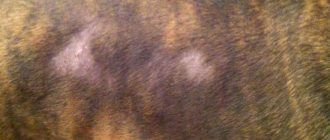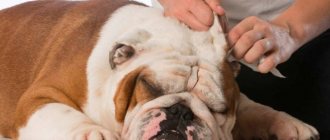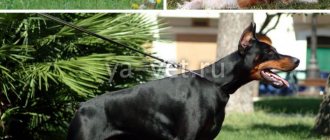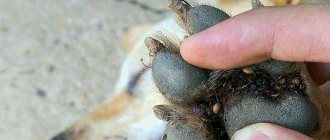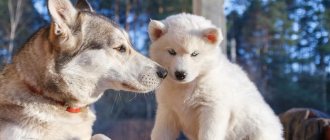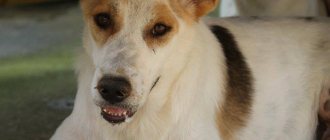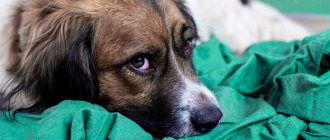Dog breeders often encounter problems associated with dermatological pathologies. These include allergic, infectious, and fungal irritations. Ringworm is a type of fungal disease that poses a danger to animals and people. Spores quickly penetrate the epidermis, spread and are transmitted by touching or using common household items.
Also read the article on the topic: “What to do if your dog has lichen: symptoms with photos, treatment and prevention.”
Features of infection
Trichophytosis and microsporium are fungi that cause a disease called lichen. Regardless of the pathogen, the symptoms and course of the disease are similar. The root causes can only be identified through laboratory tests. The spores that give rise to the fungus are distributed throughout the environment. They can withstand low and high temperatures, dampness and drought. They live up to 18-20 months, often settling on living organisms.
Spores germinate in the upper and deep layers of the skin of a dog or person, destroying not only the structure of the epidermis, but also the hair follicle - the hairs break and fall off. This is why ringworm got its name . Although there are other species in nature.
Infection can occur in several cases:
- Indirect contact with an infected animal (sharing dishes, combs, toys, blankets and clothing);
- Walking in little-known places (pathogenic spores are found on almost all environmental objects - in the ground, bushes, on stones, in mosses, etc.);
- Direct contact with an infected person, pet, urban pest (rat, pigeon).
Experts believe that mass infections occur during the cold season (autumn, winter). During this period, pets do not receive the required amount of ultraviolet radiation and vitamin D. Animals are often weakened by colds.
The main and most common cause of infection is instability of the immune system . Puppies, sick pets, and dogs after a long course of antibiotic treatment are more susceptible to lichen.
Incorrect or ineffective indoor ventilation, dampness and drafts have a positive effect on the development and spread of spores. Therefore, animals kept in nurseries are especially likely to contract dermatoses.
Prevention
Prevention of dermatophytosis is compliance with hygiene rules. It is not recommended to use other people's grooming items, equipment, beds, leashes, muzzles, transportation boxes and exhibition cages. These rules must be followed when visiting exhibitions, receiving guests, and possible contacts with potential carriers of the infection should be excluded.
Symptoms and signs
Like all dermatoses, lichen manifests itself by external signs. First of all, itchy redness and peeling occur. Then a number of specific symptoms characteristic of this form appear:
- Round red bumps (2-5 cm in diameter);
- Severe hair loss in affected areas, formation of crusts along the edges of wounds (often near the tail, on the head, limbs);
- The skin is peeling and itchy, the pet is restless, trying to get rid of the irritating scabies;
- The wounds remain pale or grayish, but reddish foci of inflammation are visible (in the center or around the area);
- When the disease is advanced, ulcers and blisters with a yellowish liquid appear, the wounds bleed;
- The claws change shape and their density increases.
initial stage
At the initial stage of the disease, as a rule, lichen in dogs most often manifests itself as localized skin lesions. Most often, lesions are observed on the head, ears and paws, that is, in places exposed to the closest contact with the external environment. Most often, lichen manifests itself as peeling, hairless patches on the skin and hair loss over large areas of the body. Sometimes, with an uncomplicated or latent course, dogs do not experience increased hair loss, and large hairless areas do not appear on the animal’s skin. A small amount of hair or individual hairs are affected, and the animal can be a carrier of the infection without having a pronounced clinical picture. In this case, the main method of diagnosis can only be laboratory tests for the detection of lichen pathogens.
How to tell if your dog is getting ringworm
It is difficult to detect the disease at the first mild stage, but an attentive owner is obliged to pay attention to the pet’s restlessness.
- 2-3 days after infection, lichen begins to multiply and manifests itself in the form of small reddish bumps-inflammations. They bother the dog and cause itching.
- Incubation can last from 10 to 40 days.
- After this, within about a week , the tubercles change to flat spots with a pronounced gray rim - a focus of inflammation. Crusts and scabs form along the edge of the wound, and the hair at the site of the lesion falls out.
- If the animal actively scratches or licks itself, the disease can spread to other parts of the body.
- The structure of the dog’s claw also changes noticeably: the plates become denser, deformed, and may change color.
Advanced stage
The disease itself is not dangerous, especially in the early stages. But without the necessary treatment, it develops into a generalized form of lichen, which means that the affected areas of the skin grow, scabs cover the entire surface of the body. This not only brings some discomfort to the pet, but also promotes further growth and development of bacteria.
The dog scratches the wounds and introduces a new infection, which not only complicates treatment, but also negatively affects the immune system.
Advanced stage
At an advanced stage of the disease, with a long course, dermatophyte fungi often infect the claws of animals. They become thinner, become dull, lumpy, and begin to flake and break. As a rule, one or more claws of an animal are affected, and in most cases these lesions are asymmetrical - only on one paw or on different limbs. The most common cause of claw damage is fungi of the genus Trichophyton.
When hair follicles are affected by spores, folliculitis will most often be clinically observed, which also develops with demodicosis and pyoderma in dogs.
When spores of dermatophyte fungi enter the deep layers of the skin in dogs, a round, dense formation, a kerion, can develop at the sites of their penetration. Most often, kerion can be found in dogs on the limbs and face.
With the development of a generalized form of lichen, one can observe lesions similar in course to dry or oily seborrhea, in which the hair becomes oily, sticky, or, conversely, dry and brittle. Dogs are less likely to develop a generalized form of lichen than cats.
According to statistics, lichen infection is more common among dogs of long-haired breeds than among short-haired ones. There is also a breed predisposition to infection with dermatophytosis in medium and small terriers. But dogs of any breed and age can get lichen.
Diagnostics
After detecting signs of lichen, you should immediately contact the clinic. The use of any drugs may change the indication of subsequent diagnostics or complicate treatment . Several types of tests are used in veterinary practice:
- Glow with a Wood's lamp (fluorescent diagnostics), some types of lichen give the fur a light green or yellow glow, but in its absence one cannot get our hopes up; it is important to carry out a full diagnosis;
- Skin scraping (carried out until drops of ichor or blood appear);
- Sowing wool sprouting around the affected area, a method that requires a long study, because colonies of the fungus must multiply and become noticeable to the human eye (using a microscope);
- Biopsy (used in rare severe cases, may not confirm the presence of lichen).
Course of the disease
Trichophytosis is conventionally divided into 3 forms:
- Superficial
- Infiltrative
- Suppurative
The first case is characterized by the appearance on the surface of the body of clearly defined foci of a pinkish color in the form of a circle or oval, on the borders of which follicular nodules can be seen. In the infiltrative form, swelling and hyperemia of the skin are observed, a purulent crust is formed, and ostiofolliculitis develops. The suppurative form of trichophytosis in dogs is dangerous due to the appearance of numerous folliculitis, combining into a massive infiltrate.
How to treat ringworm
- Treatment for ringworm cannot be planned independently. This subtype of the disease is insidious in that it can periodically subside, resetting the symptoms. But it is during this period that the fungus makes its way to the deep layers of the epidermis. The pet should be regularly examined at a veterinary clinic and repeated tests should be carried out to monitor the progress of the infection.
- First of all, when lichen bald patches are detected, the affected areas are washed with boiled warm water. The fur around the wounds is clipped (later burned to prevent the spread of spores). A protective collar is put on the pet, which will prevent it from licking the medicine or healing wounds. It is necessary to isolate the pet from family members and maintain quarantine until complete recovery.
- Scabs and crusts are softened with solutions or ointments and removed using tweezers . An antibacterial or antifungal ointment is applied to the surface of shallow lesions. If the lesions are deep, then the drugs are applied using sterile napkins or infused with a catheter.
- The complex of treatment for ringworm includes antibiotic treatment (injections or oral medications), maintaining the functioning of the liver and immune system . Antiseptic external preparations are used - sprays and shampoos for surface treatment. Traditional methods can be used in parallel, but not instead of drug therapy.
List of medications against ringworm
| Name | Price | Mode of application |
| Local treatment | ||
| Yam BC | 100-120 rubles (20 gram jar) | Ointment for external use, applied to the affected areas of the skin and around 2 times a day until complete healing and new hair sprouts. |
| Fungin | 50 rubles (10 ml) | Spray or drops are applied to the affected epidermis once a day until complete healing |
| Nizoral | 600-650 rubles (bottle) | Diluted in a ratio of 10:1 with water, wash the pet every 3 days, leave the foam for 5 minutes and rinse thoroughly |
| Alezan | 400 rubles (200 ml) | Add 10-15 ml of Alezan soap to 1 liter of water, treat with the solution, washing the affected areas of the skin, removing crusts and scabs |
| Systemic | ||
| Itraconazole | 360 rubles (pack of 15 tablets of 100 mg) | Tablets for oral use, mixed with food once a day, should be used in a dose of 10 mg of active ingredient per 1 kg |
| Griseofulvin | 250 rubles | Mixed into food 2 times a day, 20-50 mg of active ingredient per 1 kg |
| Fluconazole | 50-180 rubles per package (7 capsules of 50 mg each) | Capsules are given with food once a day 10 mg per 1 kg |
| Vaccines | ||
| Microderm | 100 rubles (1 dose) | 0.5-1 ml (depending on weight) is injected intramuscularly twice (once into one back thigh, and after 14 days into the other thigh) |
| Vakderm | 360 rubles (4 ampoules) | 0.5-2 ml are administered similar to the regimen for the previous drug |
Types of canine lichen
There are several varieties of lichen, differing from each other in symptoms and approaches to treatment. Veterinarians always tirelessly repeat that if any suspicious spot is found on a dog, it needs to be seen for diagnostics as soon as possible. That is why you are studying this information now - it will not be superfluous to be able to distinguish one form from another, in order to know how to treat lichen in a dog, and whether it is possible to become infected yourself.
Types of lichen that can be found in dogs:
- Pink;
- Shearer;
- Encircling;
- Weeping;
- Pityriasis.
Ringworm in a dog
The ringworm variety has a truly fungal nature. Either the Microsporum or Trichophyton fungus penetrates the epidermis.
Symptoms and treatment of ringworm
Microsporosis is dangerous and contagious, it is determined by the following features:
- The spots are small in size, about 2 cm in diameter;
- Lesions in a pinkish-brown palette;
- The contour is clearly defined;
- The infection is localized at the base of the tail and on the limbs;
- The animal is bothered by severe itching;
- Baldness begins around the affected areas.
This infection spreads very quickly, measures must be taken immediately; the disease without treatment leads to the death of the animal. Foci of infection should be regularly treated with antiseptic drugs Miconazole or Clotrimazole, as well as their analogues.
Ringworm
The dog’s body can react to an allergen that has entered it with the manifestation of lichen. This is eczema with an infectious nature. Anything can act as an allergen, from medications to food, especially against the background of a hormonal disorder. This is a chronic disease.
Symptoms and how to treat lichen planus
The picture will look like this:
- Small swellings will initially appear on the skin. If you touch them, they will feel hot to the touch. This will be obviously painful for the dog, and these areas are noticeably itchy.
- Over time, blisters form from the swelling and baldness begins around.
- The blisters will soon become wet and fester;
- Ringworm is most often localized on the cheeks, tailbone and neck.
- During the healing process, crusts appear on the skin, and healthy skin will be visible underneath.
The dog is suffering because its body is very itchy. She begins to scratch the damaged areas with her paws, this only contributes to the growth of the affected area. Another skin infection may also develop, and then the picture will become significantly more complicated.
How long it takes to treat the weeping form depends on the cause of the disease. If the reason for this is unsanitary conditions or an inadequate diet, then they definitely change the approach to keeping a dog. Sore spots are smeared with Ichthyol ointment, Zinc and Sulfur.
Pityriasis rosea
A viral type of skin infection can cause pityriasis rosea. Some experts are of the opinion that this phenomenon may be due to a genetic predisposition, as well as a viral disease of the gastrointestinal tract, respiratory system, or a response to an improper vaccination.
The course of the infection is chronic, complete recovery is impossible. The disease will always make itself felt with a decrease in the functioning of the immune system, with malnutrition, constant illness, and stressful conditions.
A dog with pink lichen does not pose a danger to others; this form is not contagious, with the exception of other animals with a similar genetic predisposition and weak immunity.
global $ads_google; //data-ad-slot=”2475549904″ $ads_google = empty($ads_google) ? false : true; ?> if ($ads_google == false) {?> $ads_google = true; ?> } ?>
Signs and how to treat
This is what the pink form of lichen looks like on a dog:
- Specks less than 20 mm.
- The lesions are distinctly pink in color, and the middle of the spots is yellowish.
- The rashes are concentrated in the groin and muzzle areas.
- The spots are gradually destroyed, and yellow areas with flaky skin are formed instead.
If the signs of the disease are not treated, then fungi, bacteria, and viruses can penetrate under the skin, and such a complication will be many times more serious.
Since the problem arises due to a general loss of strength, it goes away on its own, especially if you normalize nutrition and care.
Pityriasis versicolor in dogs
Malassezia is a yeast-type fungus that “lives” on the surface of the skin of both animals and humans. If there is no damage to the skin, the immune system is strong and strong, then there is no threat. If everything is exactly the opposite, then the active proliferation of the fungus begins, releasing a huge amount of caustic acid. It is she who continues to spoil the epidermis, maliciously corroding it.
Symptoms and treatment of fungus
The signs are quite simple: otherwise this type is called multi-colored due to the abundance of its shades from pinkish to brown and brown. At the same time, the affected areas of the body become bald, and the spots grow, become larger and begin to merge with each other. In a short time they cover the entire body of the dog.
The infection is treated with Clotrimazole, Miconazole, Yam BK and other antifungal agents.
Shingles in dogs
This variety is caused by the herpes virus. The lichen got its name because it spreads around the body, encircling it.
Signs and treatment
First, the animal begins to itch under the ribs and on the stomach. Soon, bubbles with liquid will become noticeable in these places, which after a few days will begin to burst and become covered with crusts.
If treatment is delayed or does not occur at all, the spread will continue throughout the body.
The itching will decrease if you give your dog antihistamines. The remaining treatment for lichen consists of using Yam ointment or Clotrimazole.
Treatment with folk remedies
Traditional methods are allowed only in combination with drug treatment. Certain methods can help in the early stages of the disease. The most common means:
- Cranberry juice (freshly squeezed only) is applied to bald patches and affected areas 5-6 times a day;
- Garlic compresses: garlic cloves are cut in half and the cut area is applied to the affected areas 3 times a day;
- Wounds are treated with iodine solution 1-2 times a day (not too intensely and often so as not to cause a burn);
- Apple cider vinegar is used similar to cranberry juice;
- The condition of the skin is improved by other solutions: birch tar, calendula tincture, onion juice, celandine emulsion, lemon juice and vegetable oil - they are washed into the skin 3-4 times a day.
Vaccination against trichophytosis
We can say that over the past years, scientists have made a lot of progress both in studying the parasitic fungi themselves and in creating methods for their destruction. And the specialists really succeeded a lot. In particular, vaccination against trichophytosis is used not only for prevention, but also for the treatment of this disease.
We would advise using the domestic drug Vakderm. During treatment, it is administered in a dose of 0.5 ml per animal weighing up to five kilograms inclusive. If the pet weighs more, exactly a milliliter is injected. Exactly two weeks later the procedure is repeated, the dosage is the same.
Danger to dogs and humans
This type of lichen belongs to the category of anthropozoonoses, that is, it is dangerous for both dogs and humans. Owners can become infected from their pet. The disease is especially dangerous for young children and people weakened by the disease, whose immune system is not yet fully functional. To treat the disease, you should immediately contact a dermatologist or infection specialist.
The scary thing about lichen is that if the hair follicles are severely damaged, after the skin is restored, bald patches may remain. If a child catches lichen in early childhood, then without proper treatment he may remain bald. In addition, infectious diseases of the epidermis caused by suppuration pose a separate threat.
If an infected person appears in the house, it is necessary to isolate him from children and other animals. In case of contact, use barrier means, and after examination or treatment, disinfect your hands.
The disease is not dangerous for the animal in its early stages. However, if left untreated for a long time, it can develop into a serious pathological form and cause other infectious problems: dermatitis, bacterial irritations.
Treatment of lichen, as well as prevention of its occurrence, should be a priority for the owner of a sick animal. Yes, fungal pathologies do not have lethal consequences or dangerous effects, but they lead to serious infectious diseases and mental concussions.
4.5 / 5 ( 2 voices)
Is it dangerous for humans?
Pet owners can contract ringworm from infected pets. To transmit a fungal disease, sometimes it is enough to simply pet the dog or wash the bowl from which he ate.
Despite the highly contagious nature of the disease, many people manage to avoid infection. The fact is that fungal spores begin to develop only when they come into contact with damaged skin. The state of the immune system is also of great importance. A healthy body independently activates defense mechanisms to avoid infection.
On a note. The risk group includes infants under 12 months, preschool children and elderly people with weakened immune systems.
